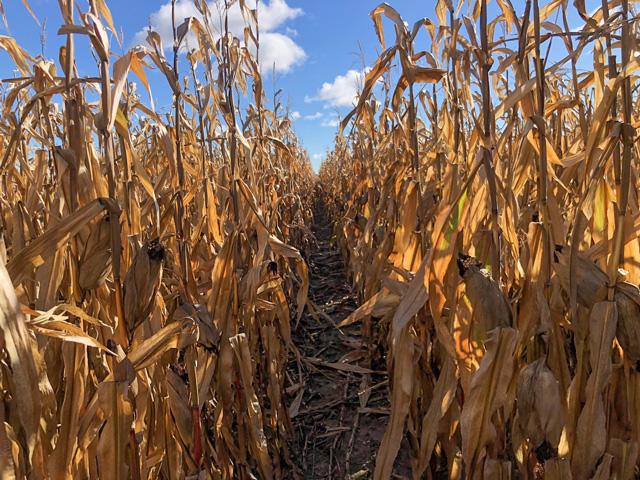Under the Agridome
Cold Winds, Fall Markets, No Soybean Nirvana
Editor's Note: Today DTN is sharing content by that is normally reserved for paying customers. Not a subscriber? Check here for a trial: https://www.dtn.com/…
**
Thursday afternoon, I was dealing with a repair on the combine. Last week, I got started at corn harvest and I'm finding it pretty good. In fact, I think it will be at record levels which puts me significantly different to the rest of Ontario where corn yields are down. In any case, by the time I got the combine repaired with the help of my local mechanic the wind changed from the north and boy, did it blow cold. With November upon us, it's not unusual to see snow at corn harvest from time to time. I miss those summer breezes so much.
Near Dresden, Ontario, where I farm, it was a beautiful summer -- slightly dry with timely rains. That is always a prescription for big crops in my part of the country. Too much rain and disease take over and things just go south. Every year is different and as we think about moving on into 2026, we need to get used to the same. No matter what we did right this year, there will be something new on the horizon challenging our management for next year. That's just another reason that risk management never grows old.
Part of that risk management is how we farm amid all the geopolitics going on around us. During this past week, we've had enough of that for a generation. In fact, we finally had the meeting between President Donald Trump and President Xi Jinping which resulted in the Chinese re-entering the soybean market. Let's just say that that's a good thing, but it is not quite what you might expect.
P[L1] D[0x0] M[300x250] OOP[F] ADUNIT[] T[]
I think what some people were expecting, especially in American farm country, is that we go back to soybean nirvana with the Chinese and their returning insatiable appetite for soybeans. However, it's not quite like that. For instance, the Chinese have agreed to buy approximately 12 million metric tons (mmt) of soybeans this market year with an additional 25 mmt annually during the next three years. Keep in mind that in the 2024-25 marketing year, China bought 22.5 mmt of soybeans from the United States. So, in many ways, having the Chinese buy 12 mmt of soybeans in this marketing year is half a celebration. In other words, it's half what it could have been before U.S. political leadership shot themselves in the foot. Remember, trade wars are easy to win. In this case, China has won this round.
The soybean futures market didn't quite know what to do on Thursday. January soybeans initially rallied up $0.20 but then turned around and lost $0.24, but finished 13.25 cents higher on the day. In fact, going back to Oct. 1, January soybeans had already rallied more than a dollar a bushel. This translated even into more money on the Canadian side when you consider the low value of our Canadian dollar. I actually had a standing order hit during this time which had been at least eight months old. Maybe it's time to put down some new standing marketing orders just as delusional as that one sounded back when I made it late last winter.
When people ask me what the price of soybeans will do next, I always respond with my standard answer that I don't know. If they persist, I always tell them that I'm holding out for $30 soybeans. This market is so frenetic now, you just don't know. Market orders standing at your elevator can help with that.
This soybean market has resulted in cash soybeans priced at approximately $14.50 a bushel in Canadian dollars. In many ways, that has been a gift to farmers who did not expect that. So, what do we do, sell now, and hope for more? Well, you know I'm at $30. Maybe I should ask what Ontario Premier Doug Ford thinks.
Well, mentioning Ford just helps me with the segue. As all of you know, it was Ford's idea to spend $75 million of taxpayer money to put together a TV ad during the World Series where former President Ronald Reagan talked about the evils of tariffs. It all made so much sense until Trump saw it and cut off trade negotiations with Canada this past week. It was a thud heard across Canada and really, I don't know where we go from here. Canadian agriculture needs trade to thrive, and it certainly hasn't been a good week for that.
So, in the meantime, now that my combine is fixed, I will get back to pursuing 300-bushel-per-acre corn. That dream seems closer to reality than I could have ever imagined it before. However, it doesn't negate all the other related problems that we have. The challenge for Ontario farmers as we move ahead is to keep our heads above water.
As I look across my cornfields Thursday night with that cold north wind cutting through, I'm reminded again how fragile all of this can be. Maybe we'll get that $30 soybean or that 300-bpa corn, or maybe not. Either way, good risk management is what keeps us in the game. It's about balancing hope with discipline, one field and one decision at a time.
**
The views expressed are those of the individual author and not necessarily those of DTN, its management or employees.
Philip Shaw can be reached at philip@philipshaw.ca
Follow him on social platform X @Agridome
(c) Copyright 2025 DTN, LLC. All rights reserved.




